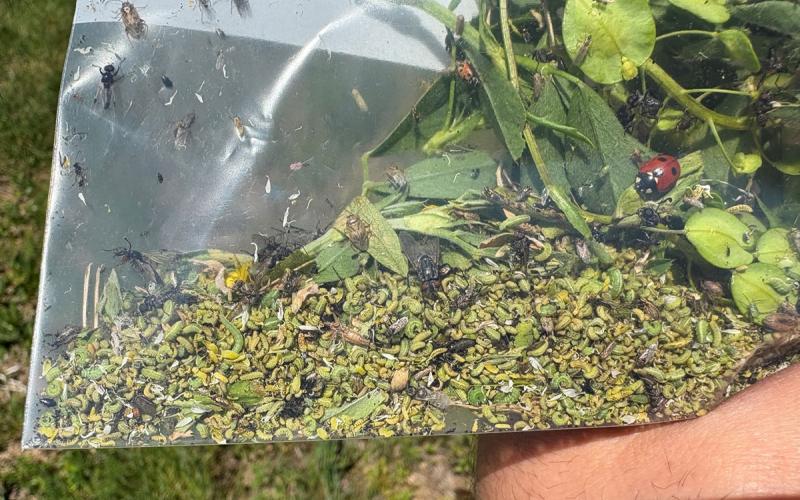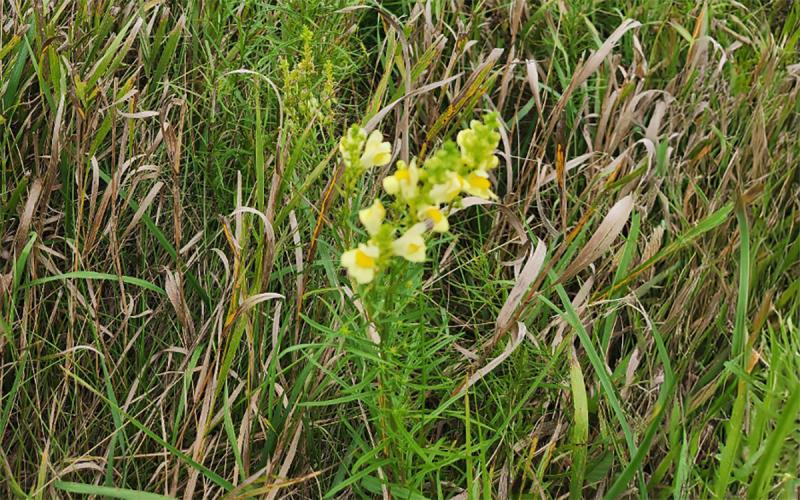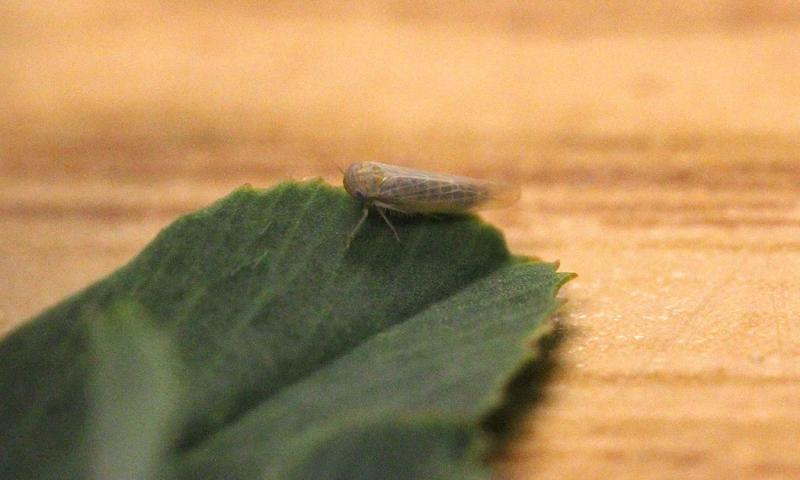
Originally Submitted: July 1, 2021
Potato leafhoppers are a migratory pest that commonly impact alfalfa fields throughout South Dakota. They cannot tolerate our cold winter temperatures, so they travel up from the southern United States each spring. Their annual migration prevents them from becoming an issue until the later alfalfa cuttings.
Feeding injury caused by potato leafhoppers resembles drought stress and, if left untreated, can reduce both yield and forage quality. Observations of potato leaf hoppers during 2021 will be important, as most alfalfa fields already have varying levels of drought stress occurring.
Profile
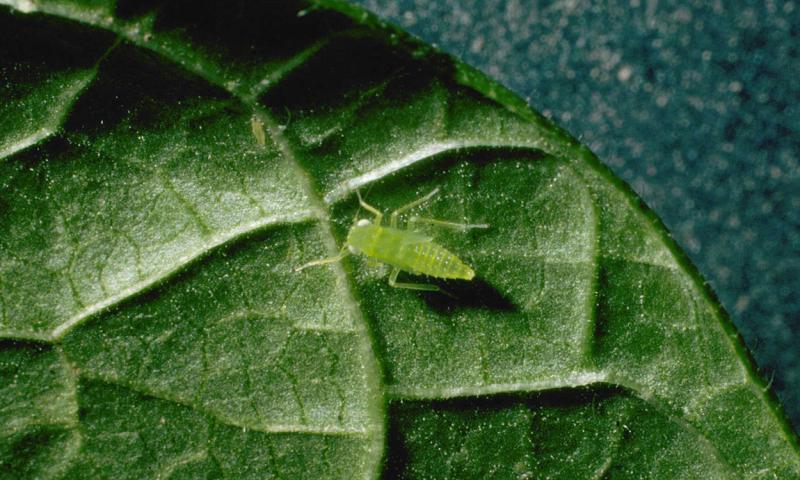
Adult potato leafhoppers are approximately one-eight of an inch long and pale-green in color. They have translucent wings that cover their bodies like a tent when at rest (Figure 1). The nymphs (immatures) vary in size and resemble adults, except they have wing pads present instead of fully developed wings (Figure 2).
Both the nymphs and adults have specialized hind legs that allow them to jump long distances. They also have piercing-sucking mouthparts that they use to feed on plant sap. Potato leafhoppers should not be confused with aster leafhoppers, which can be identified by dark markings on their heads.
Scouting
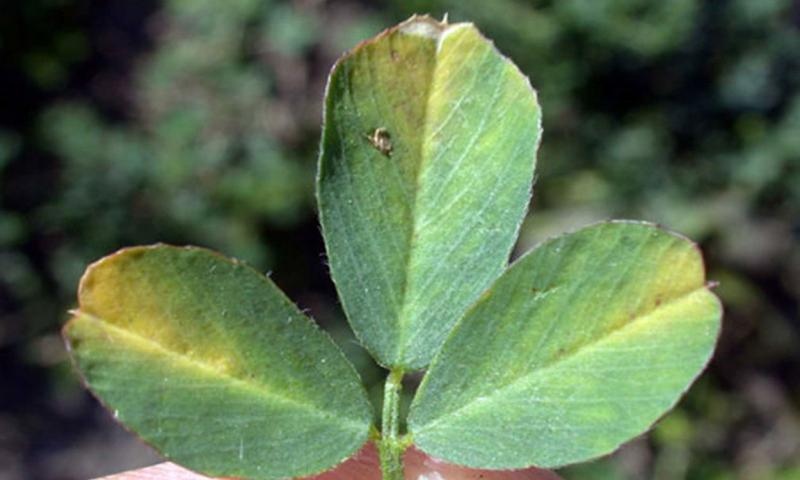
It is important to routinely scout alfalfa fields for potato leafhoppers to ensure that serious injury does not occur. Large populations of potato leafhoppers will cause stunted plants and may lead to significant losses to the tonnage and quality of the alfalfa crop. One of the first signs of a potato leafhopper infestation is the appearance of “hopper burn” in the field. “Hopper burn” occurs when potato leafhoppers use their mouthparts to probe the plants, which disrupts the cells within the leaves and turns them yellow (Figure 3).
Aside from checking fields for feeding injury, potato leafhopper populations should be scouted for by using a sweep net. It is best to sample the field edges, because this is where potato leafhoppers tend to be more of an issue. While walking in a “W” or “Z” pattern, swing the net in a 180-degree pendulum swing 25 times. Each of the pendulums (left to right) counts as a single sweep. Count the total number of nymph and adult potato leafhoppers present in the net. Next, measure the height of the alfalfa plants. Economic thresholds for alfalfa are based on plant height: zero-to-12 inches tall (Table 1), 12-to-18 inches (Table 2), 18-to-24 inches (Table 3) and 24-to-30 inches.
Economic Thresholds
|
|
||||
|---|---|---|---|---|
|
|
|
|
|
|
| Value of hay per ton |
|
|||
| $60 |
|
|
|
|
| $80 |
|
|
|
|
| $100 |
|
|
|
|
| $120 |
|
|
|
|
| $140 |
|
|
|
|
| $160 |
|
|
|
|
| $180 |
|
|
|
|
| $200 |
|
|
|
|
| $220 |
|
|
|
|
|
|
||||
|---|---|---|---|---|
|
|
|
|
|
|
| Value of hay per ton |
|
|||
| $60 |
|
|
|
|
| $80 |
|
|
|
|
| $100 |
|
|
|
|
| $120 |
|
|
|
|
| $140 |
|
|
|
|
| $160 |
|
|
|
|
| $180 |
|
|
|
|
| $200 |
|
|
|
|
| $220 |
|
|
|
|
|
|
||||
|---|---|---|---|---|
|
|
|
|
|
|
| Value of hay per ton |
|
|||
| $60 |
|
|
|
|
| $80 |
|
|
|
|
| $100 |
|
|
|
|
| $120 |
|
|
|
|
| $140 |
|
|
|
|
| $160 |
|
|
|
|
| $180 |
|
|
|
|
| $200 |
|
|
|
|
| $220 |
|
|
|
|
Management
If management of potato leafhoppers is necessary, there are a few recommendations to consider:
- Plant resistant alfalfa varieties (alfalfa that has glandular hairs or trichomes). The hairs present on the stems and leaves of these varieties prevent the adults from successfully feeding, and the nymphs may become caught and will eventually starve.
- Cut alfalfa when a potato leafhopper infestation is detected. This method is capable of disrupting potato leafhoppers and forcing them to migrate out of the field. However, there is a chance that populations will re-infest the alfalfa regrowth.
- Use insecticides to reduce potato leafhopper populations and minimize the chances of injury to the developing alfalfa. The economic thresholds for potato leafhoppers are dependent on the value of hay, cost of insecticide application and the size of the plant. For a list of insecticides that are currently labeled for potato leafhopper management, refer to the latest South Dakota Pest Management Guide: Alfalfa & Oilseeds.

